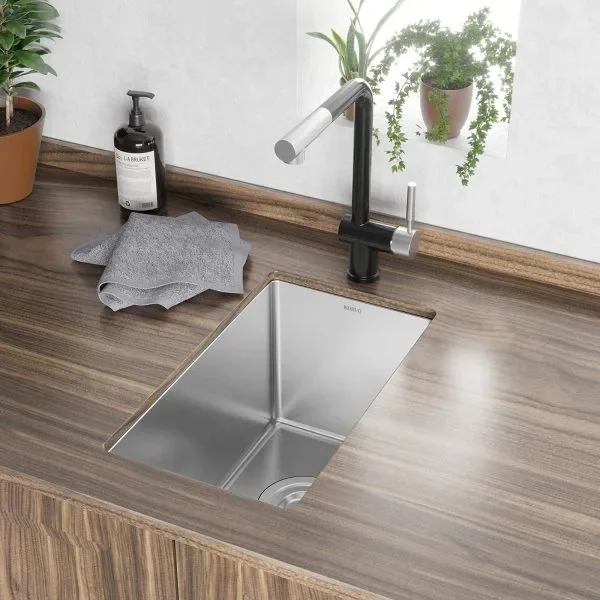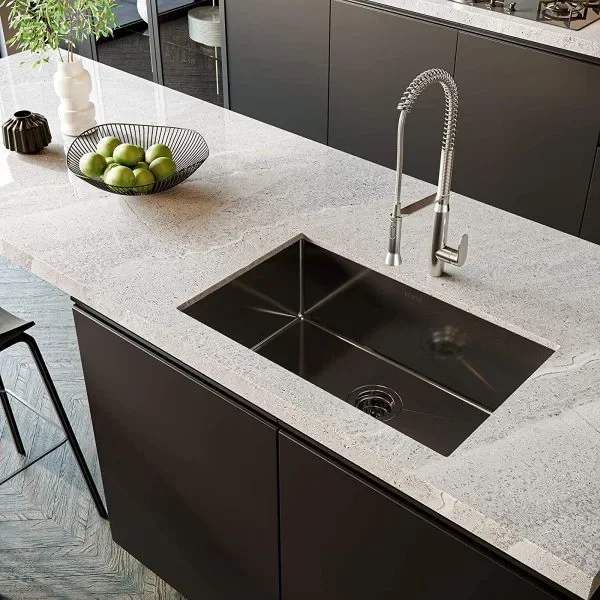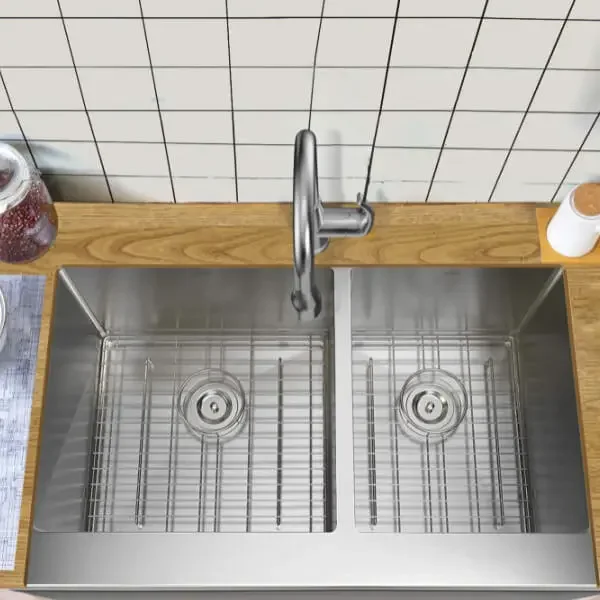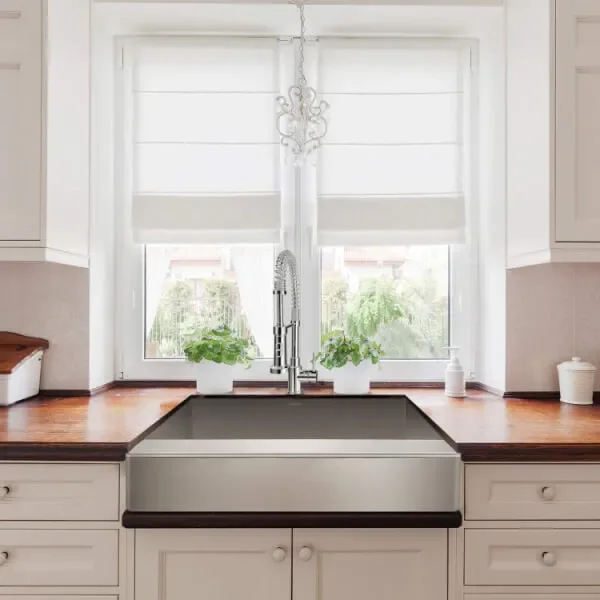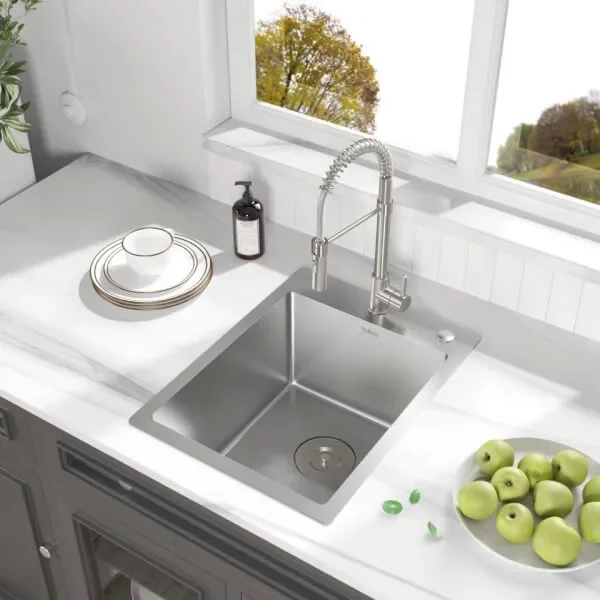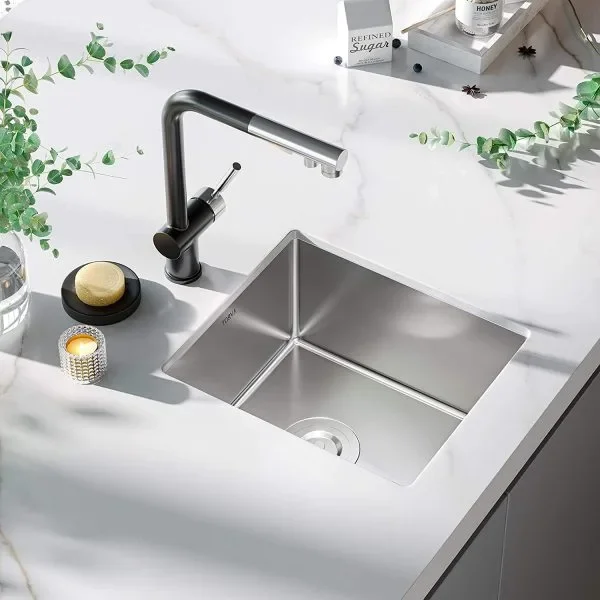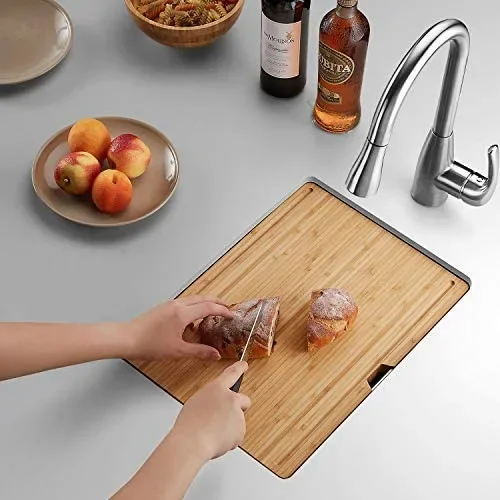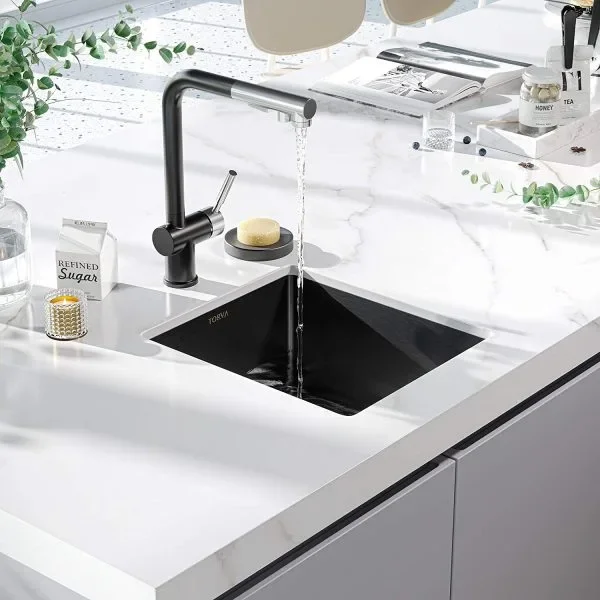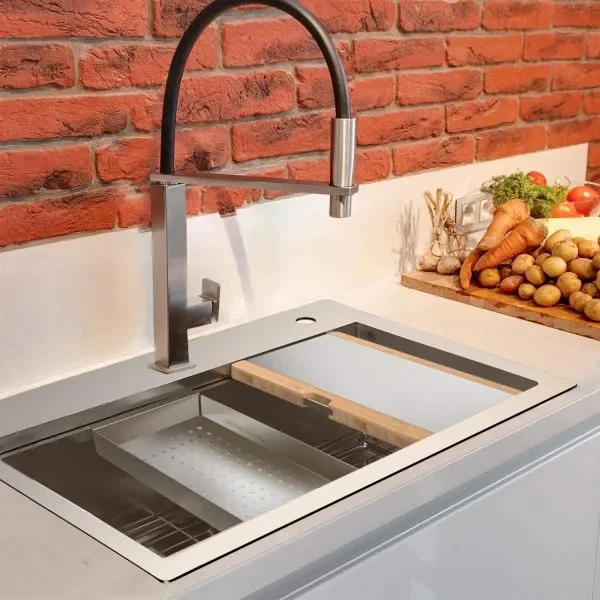Have you ever wondered what types of kitchen sinks are out there? You probably know that they come in a variety of shapes, sizes, and materials. But do you know the types of kitchen sinks available on the market? Let’s explore 11 types of kitchen sinks so you can choose which one is best for your home.
An undermount sink is a type of kitchen sink that mounts underneath the countertop. This type of sink has a sleek, modern look and is popular among homeowners who want to achieve a minimalist aesthetic in their kitchens.
Pros:
- Undermount sinks are easy to clean because they have a smooth surface that doesn’t trap food or dirt.
- They also create a seamless look in the kitchen since there is no lip or edge visible on the countertop.
Cons:
- Undermount sinks can be more difficult to install than other types of kitchen sinks.
An apron-front sink is another popular type of kitchen sink. As its name suggests, this sink has a front that protrudes out and resembles an apron. This type of sink is often used in a farmhouse or rustic-style kitchens and is known for its ample storage space.
Pros
- They can be found in many types of materials, including cast iron.
- They are easy to clean and maintain because they come with a flat surface (the sink itself) that is flush against the countertop.
Cons
- Can be difficult to clean around the faucet and knobs
An apron-front sink (single bowl) is similar to an apron front sink but has only one large bowl instead of two. This type of kitchen sink is not as common as its double-bowl counterpart because it can be challenging finding dishes that will fit in a single bowl without overlapping or touching each other.
Pros
- This type of sink can add a touch of elegance to your kitchen.
- It’s easy to keep clean because there are no tight spaces to trap dirt and food particles.
Cons
- Not suitable to accommodate large frying pans or pots.
A farmhouse sink is similar to the apron front sink, but it features a more traditional style. Many homeowners like the farmhouse sink because it is deeper than other types of kitchen sinks and can accommodate larger dishes, pots, and pans with ease.
Pros
- The farmhouse sink is deeper than other types of kitchen sinks and can accommodate larger dishes, pots, and pans with ease.
- Farmhouse Sinks offer a unique look and can make any kitchen feel like it came straight out of your grandmother’s house.
- The deep sink allows for much more counter space.
Cons
- The deep sink can make it harder to reach the bottom of larger pots and pans for cleaning.
A drop-in sink is a common type of kitchen sink that sits on top of the countertop. It does not have any hardware and can be easily installed by dropping it into a place where you want to install it. However, homeowners must be careful when choosing a drop-in sink because they do not typically come with pre-drilled holes, which means you will have to drill the holes yourself.
Pros
- This type of sink is easy to install
- It can be easily replaced if it becomes damaged
- It is a versatile sink that can be used in many types of kitchens
Cons
- Must be careful when choosing because they do not typically come with pre-drilled holes
Similar to a drop-in sink, a bar sink has no hardware and can be installed anywhere you want. However, this type of kitchen sink is typically used as an undermount or drop-in for bars since it’s perfect for serving drinks and mixing cocktails.
Pros
- Available in many different sizes
- Can be installed almost anywhere
Cons
- May not be big enough for a full-sized kitchen sink
An undermount bar sink is similar to a standard undermount or drop-in bar sink, but it’s more durable and less susceptible to scratches.
Pros
- Easy to clean
- Less susceptible to scratches
Cons
- Can be difficult to install if you don’t have experience with plumbing
A workstation bar sink is also used as an undermount or drop-in for bars, but it has a lower height and typically comes with pre-drilled holes. This type of kitchen sink makes it easy to wash your hands while serving drinks at the same time.
Pros
- There are two types of bar sinks: undermount or drop-in
- Drop-in is easier to install while the undermount requires more time and effort
- Both types of bar sinks are great for a double or triple sink to save time and space in the kitchen
Cons
- This type of sink is often made with plastic material
- The pipes are not concealed which can make it harder to find a cabinet that fits the sink
A black bar sink is a unique type of kitchen sink that is perfect for homeowners who want to add a touch of sophistication to their kitchens. It’s made from stainless steel and has a sleek, matte finish that gives it an elegant look.
Pros
- Stainless steel is very durable and easy to clean
- The sleek matte finish makes the sink look more elegant
- This type of bar sink can match any kitchen décor
Cons
- Black bar sinks can be difficult to find
- They are more expensive than other types of bar sinks
A workstation sink is a type of kitchen sink that is designed for stationary use. This type of sink typically has a large basin, which makes it perfect for washing dishes, pots, and pans. It also comes with several compartments that are great for storing cleaning supplies and other kitchen tools.
Pros
- The larger basin makes it easier to wash large dishes and pans
- The compartments are perfect for storing cleaning supplies, sponges, or other kitchen tools
- Comes in a variety of types and styles to match any kitchen décor
Cons
- Not ideal for washing vegetables or rinsing fruits since it’s not deep enough to keep them submerged in water
An integrated sink is a type of kitchen sink that has its own faucet. It’s commonly used when the homeowner wants to make sure the entire countertop will be free for other types of appliances or cooking tools.
Pros
- The sink is integrated with the faucet so you won’t have to worry about buying a separate one
- Keeps your countertop free from clutter
- Comes in a variety of types and styles to match any kitchen décor
Cons
- Can be expensive to buy an integrated sink
- It can be hard to find an integrated sink that matches your kitchen décor
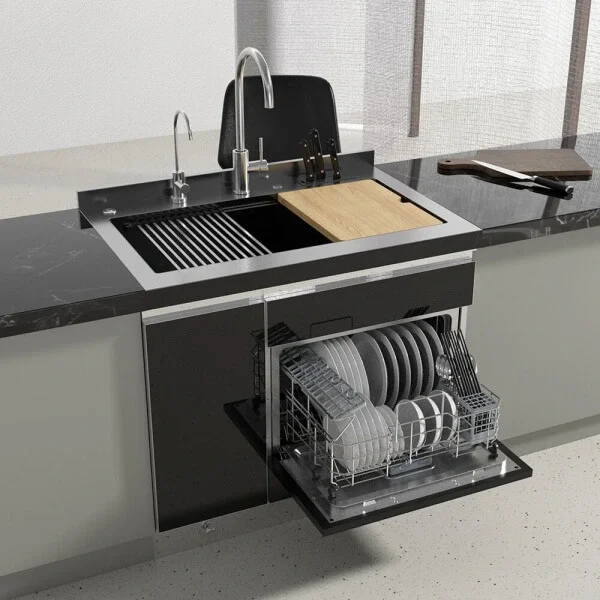
What to Consider Before Choose the Right Type of Sink?
The types of kitchen sinks that are mentioned above are just some of the many options that homeowners have to choose from. When selecting a new sink, there are several factors you will need to consider before making your final decision. Some of these factors include:
- The size of the sink– You will need to choose a sink that is the right size for your kitchen. Make sure to measure the space where you want to install it so you can get a sink that will fit comfortably.
- The type of material-Sinks are made from a variety of materials, including stainless steel, porcelain, granite, and quartz. You will need to choose a material that is durable and easy to clean.
- The style of the sink– Sinks come in a variety of styles, including a farmhouse, apron front, drop-in, bar, undermount bar, and workstation sinks. Choose a style that will complement the look of your kitchen.
- The budget– Sinks can vary in price, so make sure to choose one that fits within your budget.
- The installation type– You will need to choose a sink that can be installed in the way that you want. Some sinks, such as drop-in and bar sinks, can be installed easily by anyone. Other types of sinks, such as integrated and workstation sinks, may require professional installation.
- The maintenance– You will need to choose a sink that is durable and easy to clean.
Once you have considered these factors, you will be able to select the type of sink that is perfect for your kitchen.
How to Clean All Types of Kitchen Sinks?
Now that you know all types of kitchen sinks, it’s time to learn how to clean them. Here is some step by step instructions on how to clean different types of kitchen sinks:
- The first thing you should do is remove all items from the sink and wash them thoroughly. Then, rinse out the basin and wipe it down with a wet cloth to get rid of any excess dirt or debris. If there are hard water stains on your stainless steel sink, use baking soda mixed with a little bit of water to scrub them away.
- For types of kitchen sinks that have a double basin, use one side for washing and the other for rinsing your dishes before placing them in the dishwasher. This will help prevent any bacteria from developing since you won’t be using the same sink for both purposes like most homeowners do.
- If you have types of kitchen sinks with a lower compartment, use this area to store cleaning supplies and sponges so they are out of sight until you need them. You can also place small appliances in the compartments such as stand mixers or juicers. This will help keep your countertop clutter-free while you are cooking.
- If you have a porcelain sink, use a soft cloth and some warm water to clean it. Do not use any harsh chemicals or cleaning products as they may damage the finish on your sink.
- If you have a granite or quartz sink, use a mild detergent and cool water to clean it. Be sure to rinse the sink thoroughly afterward to remove any soap residue.
- If you have a stainless steel sink, use a soft cloth and some warm water mixed with a little bit of dish detergent. Be sure to rinse the sink thoroughly afterward to remove any soap residue.
If you follow these simple steps, your kitchen sink will stay clean and shiny for years to come.
FAQs
Any kitchen, really!
This is determined by whether you want the sink to be mounted into your countertops or not, as well as personal preference – both have their pros & cons.
Most commonly, they are made of stainless steel or porcelain – but there are a variety of materials to choose from, so be sure to research what would best suit your needs!
This will depend on the type of sink you have – be sure to read the installation instructions that come with your sink. Generally, installation is a fairly simple process.
One common problem is water leakage around the faucet, which can usually be fixed by tightening the connection. Another issue could be with the disposal – if it’s not working properly, it may be time to call a plumber.
This will depend on how dirty your kitchen gets and what type of sink you have – consult your manufacturer’s instructions for specific cleaning guidelines. In general, stains are best removed with baking soda, vinegar, or bleach – avoid harsh chemicals as they can damage your sink.
A: The best way to clean a stainless steel sink is by using a soft cloth and some warm water mixed with a little bit of dish detergent. Be sure to rinse the sink thoroughly afterward to remove any soap residue.
A: No. You should never use harsh chemicals or cleaning products on types of kitchen sinks because they can damage the finish on your sink. Instead, you should only clean types of kitchen sinks with warm water and dish detergent.
Wrapping Up!
Kitchen sinks are a necessary addition to any kitchen. They come in a variety of materials, sizes, and shapes, so it can be tough to decide which one is best for your needs. This guide should help make the decision easier – but if you still have questions, don’t hesitate to ask an expert!
Products Not Found

